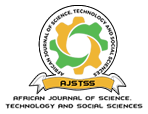Effects of soil and water conservation techniques on sorghum yield, runoff and soil moisture content in Upper Eastern Kenya
DOI:
https://doi.org/10.58506/ajstss.v1i1.35Keywords:
Soil Conservation, Water Conservation, SorghumAbstract
Water and nutrients are the main factors limiting grain production in the dry regions of sub-Saharan Africa. Given the onset of global climate change, the effects of drought stress on crop yield becomes more pronounced. Different approaches have been initiated to address this; however, they have been introduced at different times, in isolation, and at varying spatial scales. We evaluated four soil and water conservation technologies (mulching, minimum tillage, tied ridging and MBILI- intercrop) for three cropping seasons (short rains2020, long rains 2021, and short rains 2021) in the dry zones of central highlands of Kenya. The objectives were to determine effects of the technologies on run off, soil moisture content and to assess the influence of the technologies on sorghum yield. Experimental design was a randomized complete block with six treatments replicated four times. At the start of the experiment soil was sampled at 0-20cm and analysed for pH, N, P, K, C, Ca and Mg. Mulch was applied at a rate of 5t ha-1 and runoff sampled. Data were subjected to analysis of variance (ANOVA) using SAS version 9.4 and means separated using Tukey-Kramer Honest Significant Difference Test P≤ 0.05. Runoff, soil moisture and sorghum yield were significantly influenced by mulching. Run off was reduced by 50% (p=0.01) during long rains of 2021 and by 49% during short rains of 2021 under mulching treatment. During short rains of 2020 yield increased by 90% and 77% (p=0.001) under mulching and tied ridges respectively. The study highlights the importance of analyzing selected soil and water conservation technologies under rain fed conditions in response to declining food production with a focus on tied ridges and mulching.


